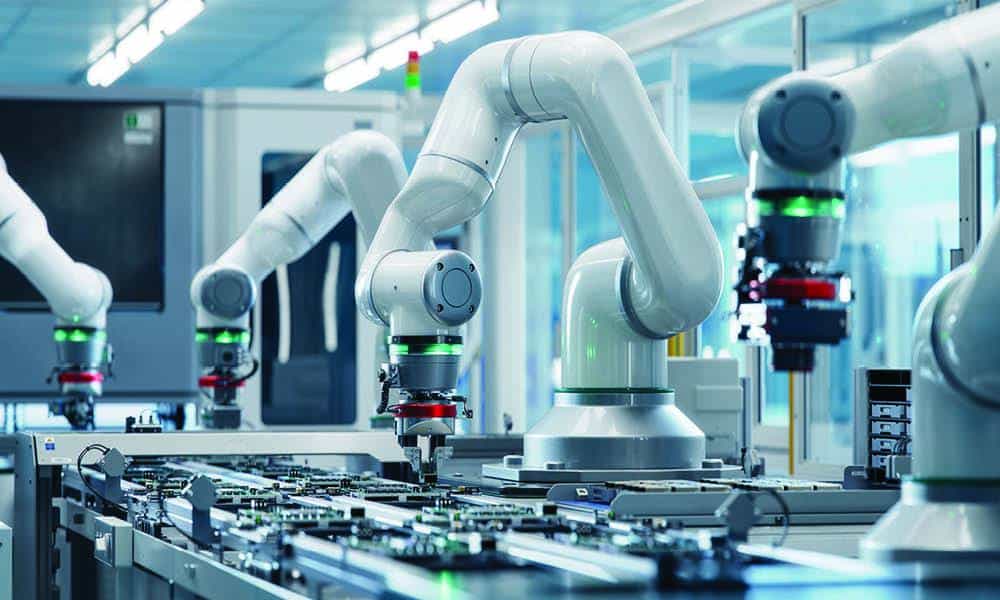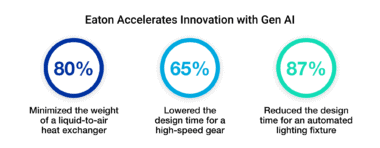From Months to Minutes: How GenAI and AI Transform Product Design and Sourcing

Manufacturers have a treasure trove of data that GenAI can use to enhance performance, agility, and growth.

TAKEAWAYS:
● By combining actual historical product data and simulated insights, manufacturers can unlock new levels of innovation and competitiveness.
● More manufacturers are harnessing GenAI—Eaton, for example, is using the technology to cut product design time by nearly 90 percent.
● Manufacturers that combine robust data sets with clear GenAI use cases are well-positioned to harness the transformative power of GenAI.
Manufacturers are already seeing glimpses of how artificial intelligence (AI) is reshaping the industry. Applying AI to R&D/product design can have a force multiplier effect across the entire product development lifecycle. Companies can use generative AI (gen AI) to develop new products at lightning speed that are already optimized for cost, carbon, performance, and even factory location. To illustrate the focus in this area, Bain & Company1 reports that 75 percent of manufacturers surveyed list AI and related technologies as their top engineering and R&D priority.
But missteps today could leave companies adrift amid the AI sea change and unable to navigate new market realities. Proactive manufacturers are addressing how gen AI capabilities differ from traditional AI, are defining specific gen AI use cases for their needs, and are taking steps to generate value from this new technology.
What is Gen AI?
Generative AI represents a new frontier in AI (ChatGPT may be the most well-known example). Traditional AI, also known as deterministic AI, applies pre-programmed rules and algorithms to make decisions. Traditional AI systems solve well-defined problems—for example, determining the most effective manufacturing process based on the properties of a specific part—and perform repetitive tasks.
Instead of using predetermined rules, gen AI identifies data patterns to create new, unique content. This requires accurate data, machine learning (ML) for powerful analysis, and large multimodal models (LMMs) to process and generate information across multiple formats, including text, images, and video.
Data Quality: The Launchpad for AI Innovation

Financial services and other industries are awash in data because different industry sub-segments—such as consumer banking and asset management—can use similar data sets to create AI models for automated customer service and other applications. But that scale doesn’t apply to manufacturing because many sectors have different operating models (think high-volume consumer electronics manufacturing vs. low-volume products for aerospace or other highly regulated industries).
To compensate, manufacturers are combining actual historical product data and simulated insights to provide the data volume and quality required to make informed decisions.
How to Capitalize on Actual Historical Information and Simulated Design Data
A manufacturer’s actual historical data can include design files of its popular products, a list of its highest-margin products, product costs, production volumes, and preferred supplier information. It can also feature detailed performance data regarding company-owned factories and/or production lines.
However, analyzing a manufacturer’s actual historical data doesn’t typically help to identify areas for cost or time savings. For example, how do manufacturers know if they’re overpaying for a component if they only have quote and payment information?
To gain these types of insights, manufacturers rely on simulation and modeling to identify opportunities for improvement across the organization—including design for manufacturing (DFM), cost modeling, sustainability insights, and structural performance (FEA analysis). These simulation applications provide additional analysis and guidance to optimize an array of variables.
“Missteps today could leave companies adrift amid the AI sea change and unable to navigate new market realities.”
Integration across applications and platforms is central to harnessing all manufacturing information effectively. With complete control over product data, manufacturers can instantly adjust shop floor labor rates for a plant in Taiwan or update raw material cost data to reflect inflationary pressures.
Manufacturers who understand why there are discrepancies between actual historical data and insights from simulation applications can use this knowledge to build precise AI models based on the most accurate information and establish parameters from multiple types of data.
Eaton Spotlights the Power of Gen AI
Eaton is a $23 billion intelligent power management solutions provider for industrial and manufacturing industries. Customers regularly require customized Eaton components/products for their new product development initiatives, which can range from passenger car valve stems to lighting fixtures.
Due to technical complexity, it can take Eaton months to complete a manual product design. For example, a lighting fixture design can require input from thermal, electrical, mechanical, optical, and manufacturing engineering.

“Eaton’s vision is to take our traditional design processes from months to minutes,” said Uyiosa Abusomwan, senior global technology manager of Digital Design and Engineering at Eaton.
Eaton’s gen AI capability is built on a robust set of actual historical product design data and insights from the company’s simulation software portfolio—including aPriori for cost modeling, DFM, and sourcing. Eaton combines this information to create detailed model-based design specifications and properties to support its gen AI development.
With gen AI, Eaton runs thousands of design iterations in minutes (or less) and proposes the top five designs. Once the designs are fed through a high-fidelity simulation, Eaton’s digital design and engineering team conducts a detailed review. This workflow empowers the Eaton engineering team to review AI outputs for product validation and quality control, and to streamline decision-making.
Result: Eaton Cuts New Product Design from Months to Minutes
Eaton’s impressive results from its high-fidelity gen AI initiative include the following:
- Minimizing the weight of a liquid-to-air heat exchanger by 80 percent
- Lowering the design time for a high-speed gear by 65 percent
- Reducing the design time for an automated lighting fixture by 87 percent
Eaton’s gen AI capabilities support the company’s goal to scale new product development and accelerate time-to-market to address customer needs. The technology could also support the company’s goal to become carbon neutral by 2030.
Take the Next Step In Your Gen AI Strategy
Despite some early forays into gen AI, manufacturers are still primarily laying the groundwork in this area. The MLC’s “Future of Industrial AI in Manufacturing” survey reports that 28 percent of respondents have gen AI projects that “passed the pilot stage.” What’s revealing is that more than half of those surveyed aren’t incorporating gen AI into their digital transformation strategies, and nearly two-thirds aren’t measuring the impact of their AI investments.
Gen AI technologies continue to evolve rapidly in this dynamic field. Given the pace of innovation, it’s hard to predict what AI algorithms will be capable of during the next few years. However, the need for accurate, robust data are a constant pillar for AI and other business-critical operations.
Today, companies have a wealth of information to harness for short-term gains and long-term success: traditional AI engines that power product design, sourcing, and digital factory simulation—along with their actual product data. Gen AI is uniquely positioned to transform the entire product development lifecycle. Manufacturers that act quickly and strategically are well-positioned to gain new levels of performance, growth, and agility. M
About the author:

Philippe Adam is the chief marketing officer at aPriori.
References:
1. Bain & Company. “Bain’s Global Machinery & Equipment Report 2024.” 2024.
2. Manufacturing Leadership Council. The Future of Industrial AI in Manufacturing. 2023.